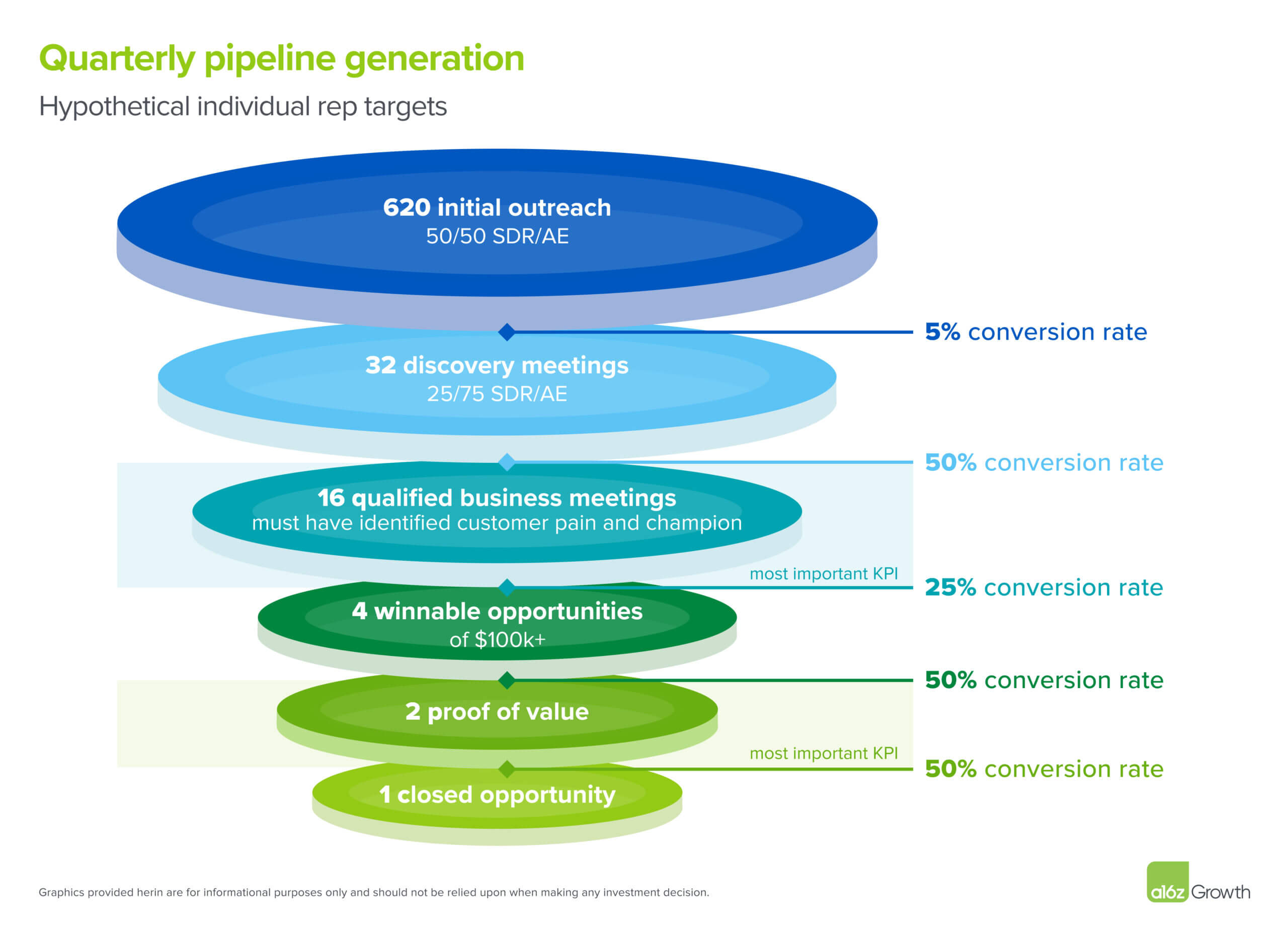In a downturn, sales teams that are accustomed to hitting quotas from inbound sources may suddenly find significant gaps in coverage as budgets tighten, projects are cut or postponed, and sales cycles lengthen. Indeed, elongated sales cycles have emerged as one of the most common themes from recent earnings calls.
Of course, it’s not just in a downturn that companies find their inbound engine is no longer enough to drive business. Whether you’re operating in a down market or your inbound motion has just reached its saturation point, in my experience, there’s only one cure for elongated sales cycles and pipeline deficits:
Go outbound and build more pipeline!
This can be a real shock to the inbound-driven, “create and close” culture of many growth stage startups. For most sales reps and frontline managers, building pipeline is the least fun part of the job, and very few account executives (AEs) or frontline managers will want to do the grunt work of cold outreach. As a result, just telling your sales team to “build more pipeline” can be a bit like screaming “get more goals!” at the scoreboard.
So, how do you transition from inbound to a mix of outbound and inbound?
In this post, I’ll dig into how some of the best startup CROs and sales leaders have added an outbound motion by creating a pipeline-first team culture, empowering their frontline managers and reps with an outbound playbook, and implementing the tools and processes to run and refine the pipeline generation (PG) process.
TABLE OF CONTENTS
Build a pipeline-first culture
TABLE OF CONTENTS
“For companies in early markets, building pipeline is the oxygen for growth. You just need to find more customers.” —Ron Gabrisko, CRO of Databricks
Building an outbound culture is hard. The best CROs explain to their teams why generating pipeline through an outbound motion is critical to both the company hitting revenue numbers and sales reps hitting their individual KPIs.
To get reps bought in, it’s important to show with data which metrics at each stage of the pipeline process, from outbound activity all the way to closed opportunities, are needed to hit quota and revenue goals. The best way to do this is to reverse engineer what the target numbers and conversion rates the best sales people hit at each stage of your outbound funnel. For instance, if the data shows that, on average, your best account execs are closing 5 deals per quarter to hit their goal, how many active winnable opportunities and proof of value engagements do they need to get those 5 deals? How many qualified business meetings to get those winnable opportunities? How many cold outreach calls and discovery meetings to get that number of qualified business meetings? Many CROs also prescribe target ratios for how to allocate outreach calls and discovery meetings between sales development reps (SDRs) and AEs.
In my experience, the two most important leading indicators for outbound success are proof of value (POV) engagements and qualified business meetings (QBMs). QBMs are defined as meetings in which you have identified 1) a clear customer pain point and 2) a champion. (For those using the MEDDPIC framework, these correspond to the Implied pain, or I, and Champion, or C). POVs capture the customer’s requirements (in MEDDPIC, defined as D, or decision criteria) and demonstrates that you can meet them both technically and financially with a business case.
 Targets alone though aren’t enough to create a culture. Many CROs run dedicated team prospecting days and competitions to motivate their teams. For instance, at Ambient.ai, every Thursday is pipeline day and reps who get the most connections spin a wheel for a prize. Jeff Huisman, head of global sales at Ambient.ai, also emphasizes the importance of building pipeline throughout the process of recruiting and onboarding new reps.
Targets alone though aren’t enough to create a culture. Many CROs run dedicated team prospecting days and competitions to motivate their teams. For instance, at Ambient.ai, every Thursday is pipeline day and reps who get the most connections spin a wheel for a prize. Jeff Huisman, head of global sales at Ambient.ai, also emphasizes the importance of building pipeline throughout the process of recruiting and onboarding new reps.
At Databricks, every Wednesday is pipeline day, and regional winners get a prize, such as cowboy boots. “We make prospecting a part of company culture. We celebrate the person who closes the $50M deal, but also celebrate those people who found 3 opportunities. Pipeline is effort. If you are willing to put in the effort, you will be a rockstar,” says Gabrisko.
The best sales leaders and CROs also lead by example by actively participating in pipeline generation. On pipeline day, Gabrisko works alongside the SDRs, competing to see who can get the most leads. Grant McGrail, CRO of Tripactions, says, “every Tuesday, our leaders get in the boat with our reps and do prospecting and recruiting. It’s 4–8 hours a week, and I have a dashboard to measure their activities.”
Create a playbook
Culture alone doesn’t make an effective outbound motion. You also need an outbound playbook so your team has a clear and consistent method and message when building pipeline. One of the best ways to create a playbook is to set up a tiger team with individuals from different key GTM functions to:
- Prioritize: What are the top target accounts and buyer personas? (If you don’t have an ideal customer profile [ICP] already, check out my previous blog on the topic.)
- Research: What should SDRs be looking for, both internally in customer and intent data and externally in annual reports and 10Q forms, when researching accounts on their list? What buying signals should they look for? What information do they need to personalize their outbound messaging?
- Tools & KPIs: What, if any, new tools will the team need? For instance, how will the team add new prospects to outbound sequences? What reports will they use to see their accounts? How can the team discover high intent signals? What activities, by channel, will they be measured on each day, week, month, and quarter?
- Outbound messaging and sequences: How will you ensure messaging is relevant, timely, and targeted? How will you customize outreach templates based on specific sequence stages and buyer persona research? How will you optimize the outreach process to avoid inbox fatigue and improve connect rates? What information does the team need to personalize their outbound messaging?
- AE & SDR partnership: What does a day in the life of an SDR and AE look like? How will AEs and SDRs work together? How often should they be meeting? What should they discuss? What are the swim lanes for each role? What information do SDRs need to provide in their pre-meeting notes for AEs?
- Discovery process: How should we uncover customer pain? How can we tell that the pain we’ve discovered is worth solving and paying for? What does a great discovery meeting look like? What high yield questions should we ask?
- Qualification process: What’s the best way to uncover a champion? How should we test a potential champion? What’s the best way to navigate an organization and understand where the power to make a purchase decision resides? How are those decisions made and what criteria will be required to win? How will the customer determine success and what metrics will they use? How will you define what a qualified opportunity entails? What qualification and discovery questions should SDRs be asking before booking a meeting?
- Execute: What constitutes a qualified business meeting? What preparation is required for a qualified business meeting and who should attend? What does meeting excellence look like? What materials should be presented at that meeting? What outcomes should we expect following the meeting and how should the proof of value process be run thereafter? What does a great business value assessment (BVA) look like? How do you build a mutual action plan with a customer and what should a great meeting with the buyer look like?
Once you’ve outlined the playbook and reviewed all of the sections with the appropriate cross-functional stakeholders, it’s time to build the materials—messaging and sales enablement, account/prospect prioritization dashboards, account research templates, AE:SDR 1:1 templates, SDR qualification guides, and so on—to onboard and train your sales organization.
Operationalize and refine the pipeline generation process
Although top-down commitment and leadership are critical to building a strong outbound motion, the success or failure of this motion often rests on how well a CRO integrates pipeline generation into the weekly routine of frontline managers and reps.
 From there, you can also break down individual rep targets into weekly targets, with a focus on those that serve as leading indicators of down-funnel outcomes. Below are some example weekly AE targets:
From there, you can also break down individual rep targets into weekly targets, with a focus on those that serve as leading indicators of down-funnel outcomes. Below are some example weekly AE targets:
- 10 target accounts per week (Note: this can be a rolling list that AEs update weekly based on how existing targets are or aren’t progressing.)
- Minimum of 5 face-to-face meetings per week
- Minimum of 5 intro calls/live touches per week
- 100 emails (net-new and followups)
- 20 net-new calls per week
To build morale, you may want to set lower, achievable targets initially, then raise those as the team achieves them. Additionally, don’t be afraid to employ a “hustle” metric that motivates day-to-day AE activity to engage prospects, such as emails sends or calls attempted. Some AE cohorts won’t want to measure these activities, so it’s particularly important to establish a strong correlation between pipeline generation and AE success.
Pipeline generation is a data-driven process, and without data, the frontline leader is flying blind as they try to inspire, motivate, coach, inspect, and hold their team accountable for pipeline generation. Once pipeline targets are set and generation is part of the weekly schedule, frontline managers need tools, such as People.ai or Gong, to track outbound efforts and conversion rates at each step of the funnel. Similarly, account managers need prospecting tools, such as Outreach or LinkedIn Sales Navigator.
Shifting from inbound-only to a dual inbound and outbound sales motion is hard work, but the payoff can be massive. As Lauren Wadsworth, head of global sales development at Twilio, says, “most companies find that a well-executed outbound pipeline generation process not only results in incremental revenue, but also a higher average selling price. Instead of letting customers decide when they want to engage with you, you take the reins and go after the accounts you want to acquire and expand.”
Thank you to Ron Gabrisko (CRO at Databricks), Matt Groetelaars (cofounder of The GTM Operators Network), Jeff Huisman (head of global sales at Ambient.ai), Grant McGrail (CRO at TripActions), Mark Regan (VP GTM operations at Segment-Twilio), and Lauren Wadsworth (head of global sales development at Twilio) for contributing their hard-earned wisdom to this piece.


